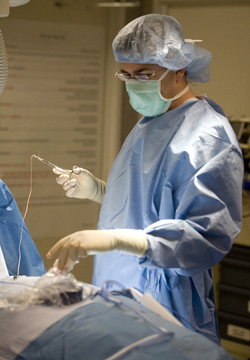
Patrick Whalen, M.D., implants a device to remotely monitor a patient’s heart rhythm. (photo by Joe Howell)
Device monitors heart rhythm remotely
Carolyn Bailey, 65, was getting into her car when she suddenly passed out and fell to the driveway, resulting in a broken ankle and a three-day hospital stay.
She thought it was an isolated incident, but two-and-a-half years later she fainted again, and this time she broke her knee.
Her latest unexplained fainting spell in July left her unable to drive, to care for her eight grandchildren and to participate in her normal activities because she didn't know when another episode would occur. She consulted with four doctors, including her primary care physician and a neurologist in her hometown of Huntsville, Ala. None could diagnose her problem.
“I just lose consciousness completely and fall down,” Bailey said. “That's really kind of scary because I don't know if I'm going to be at the top of the steps and pass out. I can't drive or take care of my grandchildren because I'm afraid I'll pass out and hurt someone. The fear of it happening again hangs over my head all the time.”
About 25 percent of healthy adults will have a fainting episode at some time in their lives. Syncope, the medical term for fainting, accounts for 3 percent of emergency room visits and 6 percent of hospital admissions every year.
Irregular heart rhythm can be a cause. As is often the case, the sporadic timing of episodes — sometimes months apart — prevents physicians from capturing relevant cardiac activity that could lead to diagnosis and appropriate treatment.
“Syncope can be tricky to diagnose,” said Jeff Rottman, M.D., professor of Medicine. “If we look at patients with episodes of passing out, and we use all of our best tools, we can identify a specific cause in about half the patients. Our goal is to be better than that.”
Bailey was referred to the Vanderbilt Heart & Vascular Institute (VHVI), which has been using remote, wireless technology to monitor arrhythmias for several years. VHVI is the first in Nashville to use the new Sleuth Wireless Remote Implantable ECG Monitoring System for this purpose.
Patrick Whalen, M.D., assistant professor of Medicine, implanted the wireless device, about the size of a 50-cent piece, near Bailey's shoulder in a minimally invasive surgical procedure.
“The procedure just took a few minutes. There was no pain. It didn't bother me at all. I came home, went out to dinner and to the bookstore,” Bailey said.
Sleuth is designed to continuously monitor and transmit ECG data from Bailey's home in Huntsville to a monitoring center, where certified cardiac technicians review data and create event reports for physicians, reducing clinic workload. As a result, Whalen can see actual electrocardiogram activity that takes place before and after Bailey's next episode, whether that happens next month or next year. The system continually monitors and records ECG data for up to two years.
“Not all syncope is caused by a heart rhythm problem. Rhythm recording devices first tell us if a heart rhythm problem is involved in syncope, and if it is, what sort of rhythm problem?” Rottman said. “Usually we use a device like Sleuth for purposes of diagnosis. Depending on the acuity, we can provide reassurance, or if we see a specific problem, we can take appropriate action.”













